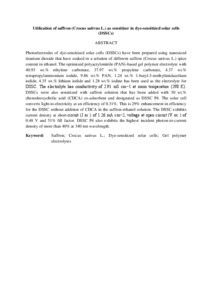Citation
Arof, A. K. and Nor, N. A. Mat and Ramli, N. R. and Aziz, N. and Noor, I. M. and Taha, R. M.
(2017)
Utilization of saffron (Crocus sativus L.) as sensitizer in dye-sensitized solar cells (DSSCs).
Optical and Quantum Electronics, 49 (37).
pp. 1-8.
ISSN 0306-8919; ESSN: 1572-817X
Abstract
Photoelectrodes of dye-sensitized solar cells (DSSCs) have been prepared using nanosized titanium dioxide that have soaked in a solution of different saffron (Crocus sativus L.) spice content in ethanol. The optimized polyacrylonitrile (PAN)-based gel polymer electrolyte with 40.93 wt.% ethylene carbonate, 37.97 wt.% propylene carbonate, 4.37 wt.% tetrapropylammonium iodide, 9.86 wt.% PAN, 1.24 wt.% 1-butyl-3-methylimidazolium iodide, 4.35 wt.% lithium iodide and 1.28 wt.% iodine has been used as the electrolyte for DSSC. The electrolyte has conductivity of 2.91 mS cm−1 at room temperature (298 K). DSSCs were also sensitized with saffron solution that has been added with 30 wt.% chenodeoxycholic acid (CDCA) co-adsorbent and designated as DSSC P4. The solar cell converts light-to-electricity at an efficiency of 0.31%. This is 29% enhancement in efficiency for the DSSC without addition of CDCA in the saffron-ethanol solution. The DSSC exhibits current density at short-circuit (J sc ) of 1.26 mA cm−2, voltage at open circuit (V oc ) of 0.48 V and 51% fill factor. DSSC P4 also exhibits the highest incident photon-to-current density of more than 40% at 340 nm wavelength.
Download File
![[img]](http://psasir.upm.edu.my/63667/1.hassmallThumbnailVersion/Utilization%20of%20saffron%20%28Crocus%20sativus%20L.%29%20as%20sensitizer%20in%20dye-sensitized%20solar%20cells%20%28DSSCs%29.pdf)  Preview |
|
Text (Abstract)
Utilization of saffron (Crocus sativus L.) as sensitizer in dye-sensitized solar cells (DSSCs).pdf
Download (106kB)
| Preview
|
|
Additional Metadata
Actions (login required)
 |
View Item |

